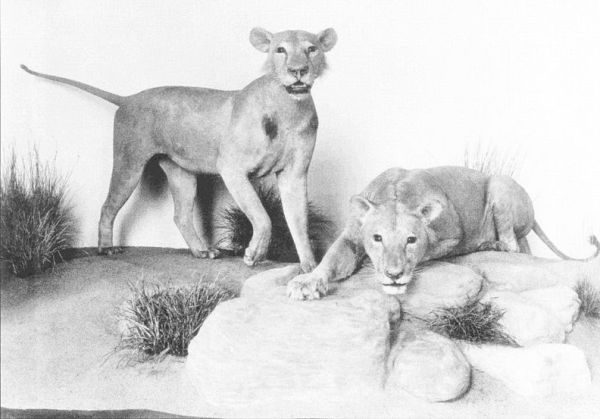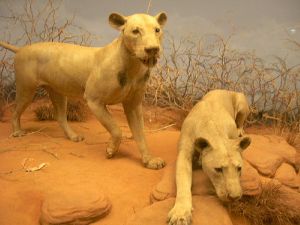Maneless Maneaters May Leave USA
Posted by: Loren Coleman on October 30th, 2007

During the fall, coming in and out of the news, has been the demand from Kenya that Chicago’s Field Museum return the remains of two lions that reportedly killed about 135 Indian railworkers (but probably actually only about 25) in the 1890s, before being shot by a famed British railway engineer. These lions are the infamous maneaters of Tsavo.
Railway engineer Lieutenant-Colonel John Henry Patterson – whose adventures formed the basis of the Oscar-winning 1996 movie The Ghost and the Darkness, starring Michael Douglas and Val Kilmer, shot the strange cats in December 1898. Twenty-six years later Patterson sold the specimens, consisting of the lions’ skulls and hides, to Chicago’s Field Museum for US$5,000.
Now, however, Kenya, via the National Museum of Kenya, wants the mounted bodies back and hopes for them to be part of an upcoming exhibition in the U.S. on Kenyan history.

What interests me from a cryptozoological and zoological point of view is how unusual these lions are. Both males, perhaps brothers, they displayed almost no manes. These 1898 man-eaters were adults, between eight and ten years old; most males develop manes by age five. Maneless male lions are not unknown, but in this example, for them to be infamous killers as well, certainly makes them memorable.
Other maneless male lions have been found in the Tsavo area, in modern times.
It seems a tangible mystery, worthy of noting, as who knows what other maneless lions, in various ranges, have a natural human-eating side to them? Indeed research in the Tsavo area has shown that lions there have been eating humans long before the 1800s, and up until at least the 1940s and perhaps today, too.
Prehistoric humans were on the diet of lions long ago. It would have been more surprising had the human-feeding patterns among a small specific population of maneless lions in Kenya had stopped just because humans wanted to build a railroad through the country.
About Loren Coleman
Loren Coleman is one of the world’s leading cryptozoologists, some say “the” leading living cryptozoologist. Certainly, he is acknowledged as the current living American researcher and writer who has most popularized cryptozoology in the late 20th and early 21st centuries.
Starting his fieldwork and investigations in 1960, after traveling and trekking extensively in pursuit of cryptozoological mysteries, Coleman began writing to share his experiences in 1969. An honorary member of Ivan T. Sanderson’s Society for the Investigation of the Unexplained in the 1970s, Coleman has been bestowed with similar honorary memberships of the North Idaho College Cryptozoology Club in 1983, and in subsequent years, that of the British Columbia Scientific Cryptozoology Club, CryptoSafari International, and other international organizations. He was also a Life Member and Benefactor of the International Society of Cryptozoology (now-defunct).
Loren Coleman’s daily blog, as a member of the Cryptomundo Team, served as an ongoing avenue of communication for the ever-growing body of cryptozoo news from 2005 through 2013. He returned as an infrequent contributor beginning Halloween week of 2015.
Coleman is the founder in 2003, and current director of the International Cryptozoology Museum in Portland, Maine.










Recent research has found that the thickness of a lions mane is linked directly to local climate. The colder the climate the thicker the mane, and vice versa.
The adult male lions of Tsavo often thinner, shorter manes, and sometimes no manes at all.
The lack of a mane in both of these animals is just an example of the latter.
I was just at the field museum a week or two ago. They are contained in the exhibit with all of the other stuffed and mounted animals (quite a large collection). Not much information is given about them.
Although I remember reading on the display that the lions were actually larger than what is on display. After they were killed they were skinned and (if i remember correctly) not all of the ‘hide’ was found to put them together.
A maneless male might have a lot of trouble gaining a pride of females, and not have the advantage of the pride hunting, perhaps leading to man-eating?
Actually, field studies of the generally maneless lions of Tsavo show they get more females and did not end up sharing their harems with as many males as lions in other areas of Africa do.
Didn’t want to bog down the blog with a lot of research and citations, but there’s been some intriguing studies done with these lions this century. Do a google search.
These lions make for a very interesting story. Could they perhaps be a separate subspecies? I too would like to know if there is any correlation between hairless manes and tendency to actively attack humans. Taking our ego aside, humans are actually quite easy prey for a lion when not armed. It makes sense that they should see us as a viable prey animal, especially when hungry. However, these lions demonstrated a startling, fearless willingness to actively hunt humans that is not seen in most lion populations. I wonder what it was that made the lions of this area like this? Could it be something about the environment? Genetics? A heightened aggression linked to a mix of environmental factors AND genetics? Was it a threat of starvation? A behavior altering disease? Very fascinating to speculate about.
I practically grew up on weekends at the Field and the story of the Tsavo Lions,taxidermy of Carl Akeley, Malvina Hoffman’s anthropological bronzes, and the murals of Charles Knight filled my imagination and informed my views on the world an the tragedy of its discovery.
The notion of lending the mounted subjects to Kenya is a lot more palatable than returning them as a form of lost patrimony. As for the lions themselves, I don’t know if it’s been noted but back in the earlier colonial days in Africa, just as everywhere during that period of expansion, work crews needed to eat and local tribesmen and imported commecial hunters wiped out huge numbers of local animals, leaving a disrupted population balance which rebounded in many strange ways and altering our early observers idea of what the untamed wilderness was all about and leading us to some inaccurate conclusions on nature in balance.
I just finished a fascinating book on this: Ghosts of Tsavo, by Philip Caputo. A slighly newer and more scholarly work, The Lions of Tsavo by Bruce Patterson, is on my “to do” list.
What, no reference to the Tsavo incident inspiring the plot of the early 3-D movie “Bwana Devil”?